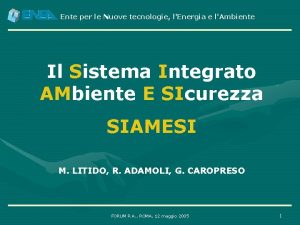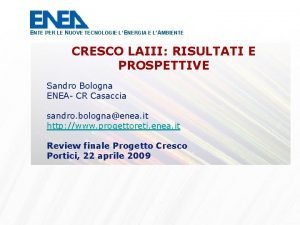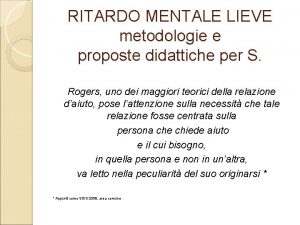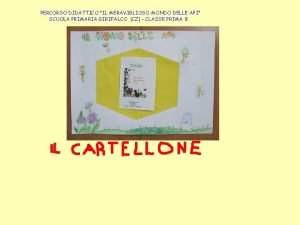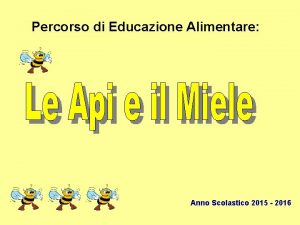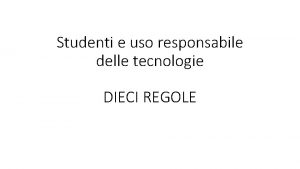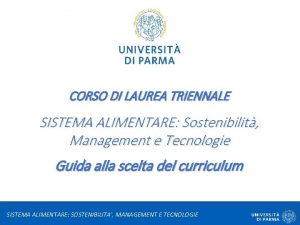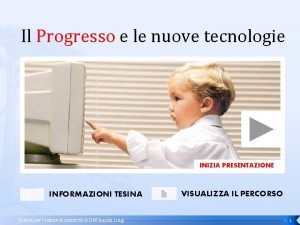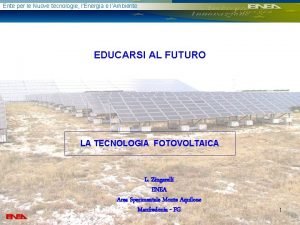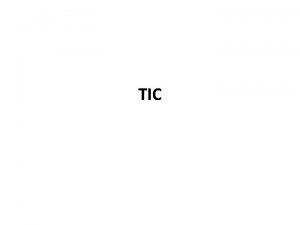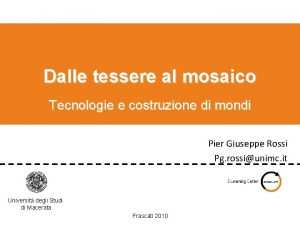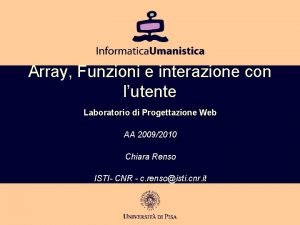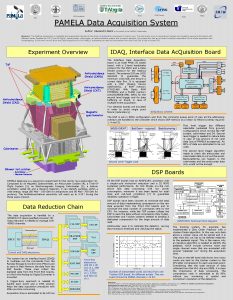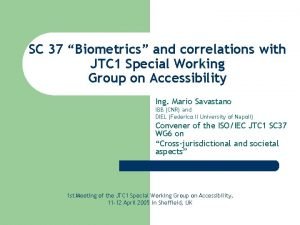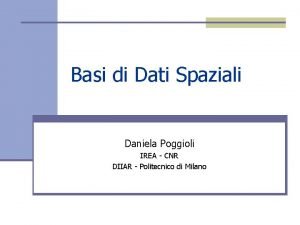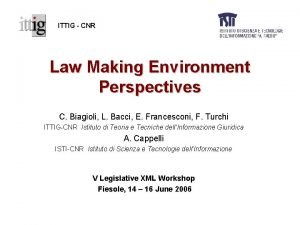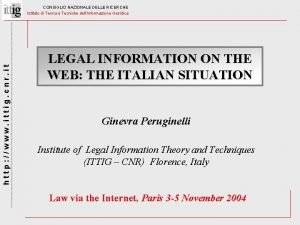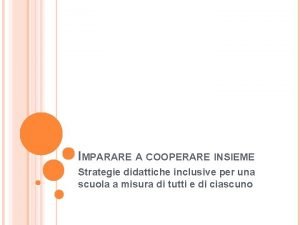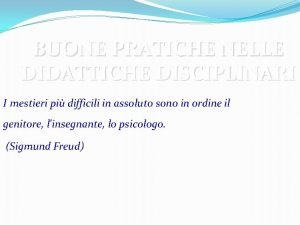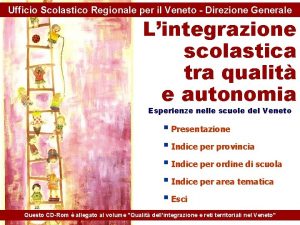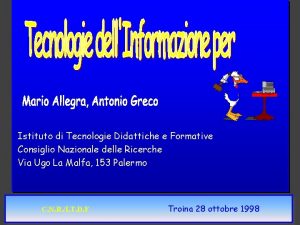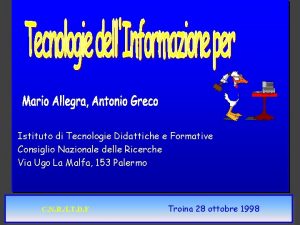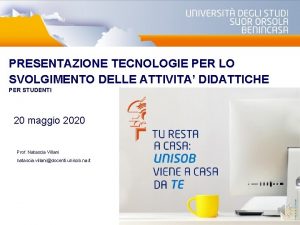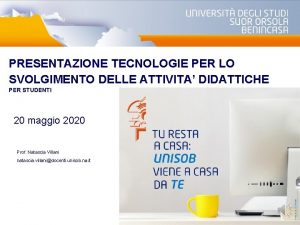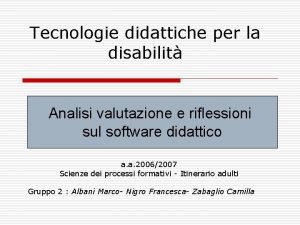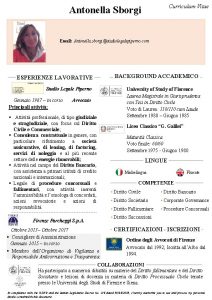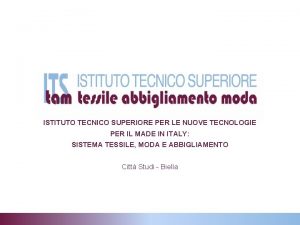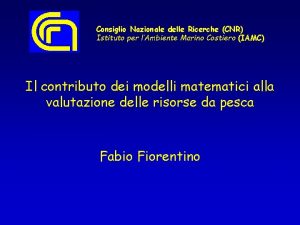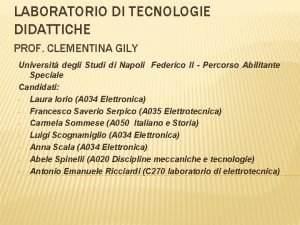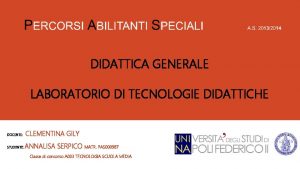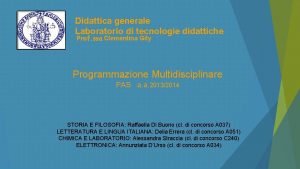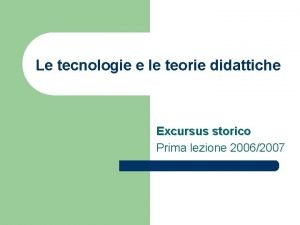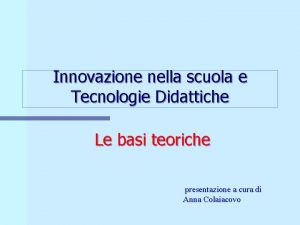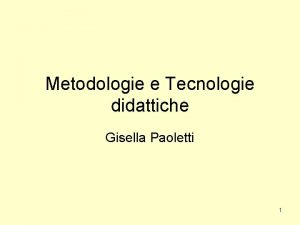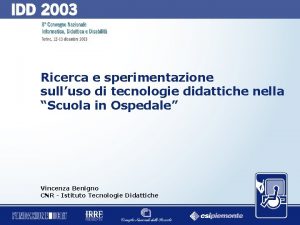Antonella Chifari Istituto per le Tecnologie Didattiche CNR

























- Slides: 25

Antonella Chifari – Istituto per le Tecnologie Didattiche, CNR U. O. Palermo What is Flipped Learning?

Authors (2012) Jonathan Bergmann has been an educator for 25 years and holds a masters degree from the University of Colorado in Instructional Technology. He currently teaches science at Woodland Park High School in Woodland Park, Colorado. In 2002 he was awarded the prestigious Presidential Award for Excellence for Math and Science Teaching. He is a national board certified teacher in Adolescent and Young Adult Science. In 2009 he was named a semi-finalist for Colorado Teacher of the Year. Aaron Sams has been an educator for 12 years. He currently teaches science at Woodland Park High School in Woodland Park, Colorado where his peers consider him to be an innovator in the implementation of technology in the classroom. He has taught many staff development courses, primarily in the area of technology integration. He was awarded the 2009 Presidential Award for Excellence for Math and Science Teaching. Aaron recently served as co-chair of the Colorado State Science Standards Revision Committee. Flip your Classroom: Reach Every Student in Every Class Every Day

Association of Flipped Learning Network (2014) While often defined simplistically as “school work at home and home work at school, ” Flipped Learning is an approach that allows teachers to implement a methodology, or various methodologies, in their classrooms.



Flipped classroom and Flipped learning The terms Flipped Classroom and Flipped Learning are not interchangeable. Flipping a class can, but does not necessarily, lead to Flipped Learning. Many teachers may already flip their classes by having students read text outside of class, watch supplemental videos, or solve additional problems, but to engage in Flipped Learning, teachers must incorporate the following four pillars into their practice. Jonathan Bregman and Aaron Sams of Woodland Park High School, 2004

The four pillars of F. L. I. P.

The four pillars of F. L. I. P.

The four pillars of F. L. I. P.

The four pillars of F. L. I. P.




According to the Bloom’s taxonomy of cognitive levels, the skills in the cognitive domain can be classified into six levels: knowledge, comprehension, application, analysis, synthesis and evaluation. • In the traditional approach, the focus of classroom teaching is on the lower cognitive levels such as remembering, understanding and, to some extent, application. As these cognitive levels involve very little student participation, the learning tends to be passive. • The higher cognitive levels such as analysis, synthesis and evaluation, which lead to active learning and develop higher order thinking, are often neglected.

Flipping a classroom not only helps students achieve better learning outcomes but also provides teachers an opportunity to improve the quality of their inputs.


Main characteristics of the flipped classroom (Abeysekera and Dawson 2014; Bishop and Verleger 2013; Kim et al. 2014) (1) Changes in the usage of class time: Those teaching contents that were traditionally taught through direct instruction and can be understood by students themselves are provided in other forms, such as video, for students to learn outside the classroom. Besides, in-class discussion, projects, and problem solving are included in the class to help students apply what they have learned and to cultivate their analytical and judging abilities. (2) Changes in the usage of time outside the class: The time used to do homework is moved to the class time. Different ways of selflearning, such as watching videos, are scheduled before the class time. (5) Technology is used, especially video. While some scholars have argued that technology is not a necessary element for self-learning before class time, undeniably, it is the easiest way to present teachers’ instruction of the learning contents. Besides, teachers can manage the video and teaching materials for students more conveniently through teaching platforms or other online systems, and have interaction with students before and after class. Therefore, technology benefits the implementation of the flipped classroom. (3) The time outside the class time is designed for students to gain knowledge at the remembering and understanding levels. (4) Peer interaction, student–teacher interaction, and problem-solving skills are emphasized in class. Students gain knowledge at the applying, analyzing, and evaluating levels.

Researchers have indicated some of the reasons why flipped learning has been adopted by so many educators (Bergmann et al. 2011; Francl 2014; Lasry et al. 2014). (1) Teachers should make good use of the multimedia technology to provide students with teaching materials and allow them to learn without time or space limitations. Students are taught to collect information before class and are expected to be active learners responsible for their own learning. (2) The teaching video allows students to review and preview to have profound prior knowledge before class, and lets those students who miss classes catch up. (3) Multimedia digital teaching materials are easy to save, manage, revise, and impart. (4) In the process of preparing a flipped classroom, educators can inspect and reflect on the whole curriculum and improve the teaching contents and activity design.

Researchers have indicated some of the reasons why flipped learning has been adopted by so many educators (Bergmann et al. 2011; Francl 2014; Lasry et al. 2014). (5) With enough prior knowledge, students have more time to conduct higher level activities and questions. Educators can further provide individualized consulting, which benefits students with learning difficulties the most, and teachers would better understand the learning status of their students. (6) In-class activity and discussion can increase teacher and student as well as peer interaction. An active atmosphere can improve students’ learning motivation and, through peer pressure, the learning effects would increase. (7) More teaching strategies, such as project-based learning and problemsolving learning, can be imported into the classroom to promote higher order thinking abilities, which would be more meaningful. https: //www. youtube. com/watch? v=k. TLLRbce. Do. M

Advantages of FLIP • Self-paced learning: Each student learns at his or her own pace. A traditional classroom in which the educator uses a one-size-fits-all approach to teaching cannot effectively cater to students who learn differently. However, in a flipped classroom, the availability of online videos and instructional material enables a learner to pace the learning process according to his or her learning needs. Learners have the flexibility to learn any time during the day. They can choose to pause, rewind or replay an instructional video—which they cannot do when they are in a conventional classroom. This helps students understand concepts, compile queries and take notes at their own pace. On the other hand, such a model also provides quick learners with an option to accelerate their learning process. • Multiple Ways of Learning: Since the instruction is not restricted to classroom teaching, the teacher has an option of sharing with students different types of content. A teacher may share interactive animations, simulations, informative websites and any other content which can help students understand the concepts better.

Advantages of FLIP • Effective Feedback: As the students go through the instructional material and compile their queries in advance, the in-class time is used by the educator to give effective feedback. The teacher can use the extra time available to have individual interactions with students and provide extra inputs to students who find it difficult to understand the concepts. • Student-Centered Learning: The in-class time can be used by teachers to promote active and deeper learning. The teachers use different approaches such as problem solving, collaborative learning, peer instruction and carry out activities that focus on higher cognitive levels and promote critical thinking. • Effective “Homework”: As opposed to the traditional approach, in the flipped classroom model, the students solve exercises in the classroom in the presence of the teacher. This helps teachers provide timely feedback and assistance to students individually. This improves the problem solving ability of students, thereby increasing their confidence levels.

Disadvantages of FLIP • Technological Barriers: In this model, the students are expected to view online lectures which in turn require them to have access to computers and the internet. The fact that large sections of student population do not have access to such resources is a big challenge in implementing this model. • Lack of Student Motivation: Student participation is critical to the success of the flipped classroom model. Unless the students go through the instructional material and video lectures in advance, the in-class time cannot be used by the teacher to provide effective feedback and carry out activities that promote higher order thinking skills. • Ineffective Design of Learning Environment: The flipped classroom model requires the educator to identify the different components of the learning environment so that students benefit from the model. The model would fail to achieve its objectives if the online lectures are not effective and the in-class activities are not well designed and planned.

ALERT • A Flipped Classroom is not • Intructor simply creating lecture videos • Student simply watching lecture videos • Instructor simply giving clarifications in class The instructor needs to create structured learning activities, to be carried out in class, for students to apply what they learnead from the videos. https: //www. youtube. com/watch? v=yz. MFd. DT 6 FSA

REFERENCES • Bergmann, J. , & Sams, A. (2012). Flip your classroom: Reach every student in every class every day. International Society for Technology in Education. • Berrett, D. (2012). How ‘flipping’the classroom can improve the traditional lecture. The chronicle of higher education, 12. 3. • Bishop, J. L. , & Verleger, M. A. (2013, June). The flipped classroom: A survey of the research. In ASEE National Conference Proceedings, Atlanta, GA. • Roehl, A. , Reddy, S. L. , & Shannon, G. J. (2013). The flipped classroom: An opportunity to engage millennial students through active learning strategies. Journal of Family & Consumer Sciences, 105(2), 44 -49. • Fulton, K. (2012). Upside down and inside out: Flip Your Classroom to Improve Student Learning & Leading with Technology, 39(8), 12 -17.

• https: //prezi. com/gadzueswoyf 6/flipped-classroom-con-testo-dicommento/ • https: //www. it. iitb. ac. in/nmeict/e. Videos/Pedagogy_Main_workshop _2015/Lectures/video/PP 1_S 012_Flipped%20 Classroom. mp 4 • https: //docs. google. com/forms/d/e/1 FAIp. QLSe. FDAXOMMLbtz 5 H 5 wk Ezi. FVVFn. RTg. RQU 5 p. W 09 N 6 Bdbbvxckr. A/viewform
 Ente per le nuove tecnologie
Ente per le nuove tecnologie Ente per le nuove tecnologie
Ente per le nuove tecnologie Slidetodoc.com
Slidetodoc.com Il meraviglioso mondo delle api
Il meraviglioso mondo delle api Il ciclo del miele scuola primaria
Il ciclo del miele scuola primaria Uso responsabile delle tecnologie
Uso responsabile delle tecnologie Sistema alimentare sostenibilità management e tecnologie
Sistema alimentare sostenibilità management e tecnologie Oliver twist tesina terza media
Oliver twist tesina terza media Nuove tecnologie fotovoltaico
Nuove tecnologie fotovoltaico Cos'è la tic
Cos'è la tic Mosaico tecnologie
Mosaico tecnologie Gestform
Gestform Cnr
Cnr Cnr iom
Cnr iom Ibb cnr
Ibb cnr Cnr mri
Cnr mri Libro matricola cnr
Libro matricola cnr Addreesee
Addreesee Ittig cnr
Ittig cnr Cnr mri
Cnr mri Ho sceso un milione di scale analisi
Ho sceso un milione di scale analisi Strategie didattiche inclusive
Strategie didattiche inclusive Buone pratiche di didattiche disciplinari
Buone pratiche di didattiche disciplinari Clima sinico
Clima sinico Autonomia scolastica mappa concettuale
Autonomia scolastica mappa concettuale Strategie didattiche inclusive
Strategie didattiche inclusive
